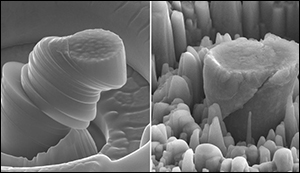UCLA Researchers Create Exceptionally Strong and Lightweight New Metal
28. 12. 2015 | UCLA Engineering | engineering.ucla.edu
A team led by researchers from the UCLA Henry Samueli School of Engineering and Applied Science has created a super-strong yet light structural metal with extremely high specific strength and modulus, or stiffness-to-weight ratio.
The new metal is composed of magnesium infused with a dense and even dispersal of ceramic silicon carbide nanoparticles. It could be used to make lighter airplanes, spacecraft, and cars, helping to improve fuel efficiency, as well as in mobile electronics and biomedical devices.

To create the super-strong but lightweight metal, the team found a new way to disperse and stabilize nanoparticles in molten metals. They also developed a scalable manufacturing method that could pave the way for more high-performance lightweight metals.
The researchers’ new silicon carbide-infused magnesium demonstrated record levels of specific strength — how much weight a material can withstand before breaking — and specific modulus — the material’s stiffness-to-weight ratio. It also showed superior stability at high temperatures.
Read more at UCLA Engineering
Image Credit: UCLA Engineering
-jk-




